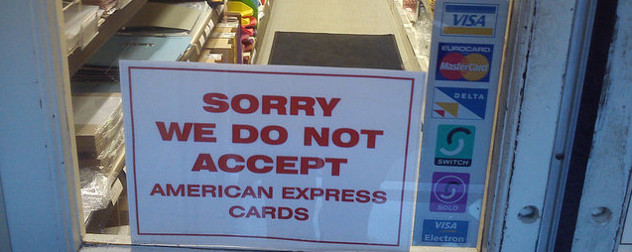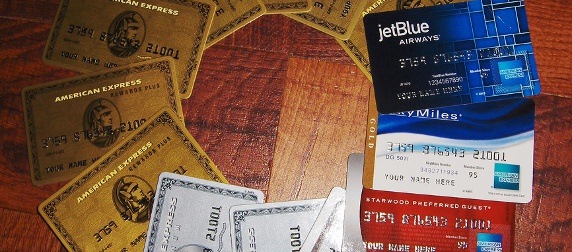From the look on the shopkeeper’s face at a small Canadian country store and gas station, you would have thought I had pulled a gun out of my pocket. But it was just an American Express card.
He began to plead with me. Did I have any other card at all? Visa? Mastercard? A debit card? He might have accepted a library card if I had handed him one. Anything, he begged, but American Express.
This was a few years back, when oil prices were high and the Canadian dollar was low. I might have put 80 Canadian dollars’ worth of fuel in my tank. The store owner told me AmEx would charge him 9.9 percent on an international transaction, causing him to take a loss on the sale. One look around the nearly barren store told me it was a loss he truly could not afford to take.
I gladly fished another card out of my wallet, paid for the fuel and went on my way.
Looking back, I think the strangest part of the experience is that this merchant accepted American Express cards in the first place. I doubt there are many big spenders – the kind AmEx likes to promote to its merchants to justify its comparatively high fees – in that remote corner of North America. I see little point in contractually obligating oneself to accept a form of payment that you have to beg your customers not to proffer.
That is, in fact, the route many merchants take. According to the Nilson Report, about 9 million U.S. businesses accepted American Express in 2017, while about 10.9 million accepted Mastercard and Visa.
What U.S. businesses cannot do, however, is accept AmEx but offer discounts or other incentives for customers who pay with cards that charge less. The Supreme Court recently ruled, in Ohio v. American Express Co., that AmEx can contractually require merchants to accept its cards on the same terms its competitors enjoy. A coffee shop cannot charge less for a latte purchased with a Visa than for one purchased with an AmEx; it can accept the pricier card on the same terms or not at all.
Thanks to Dodd-Frank, merchants can offer discounts for cash transactions, as long as the difference is made clear to customers before the transaction takes place. And most of us have encountered small businesses that set a minimum dollar amount for credit card transactions. For small purchases like lattes, these strategies may help retailers a little. But a U.S. Bank survey found last year that 76 percent of respondents never carry more than $50 at a time, and 23 percent routinely carry $10 or less. For the most part, it’s a world that belongs to plastic (or digital, as options such as Apple Pay and Google Pay make credit card payments occasionally cardless).
American Express is not the only credit card company to benefit from its Supreme Court victory. Visa and Mastercard are reportedly on the edge of settling a long-running class action lawsuit centering on the companies’ transaction fees. As Marketwatch observed, paying a settlement reported around $6.5 billion isn’t usually good news. For Visa and Mastercard, however, it may mean the end of a struggle that has stretched out over more than a decade and a signal to merchants that they have less leverage than they thought, since the AmEx ruling makes it much harder for merchants to prove that credit card companies’ practices are anticompetitive.
For merchants, the reality is that handling any credit card is expensive. It can be particularly burdensome for small grocers and other retailers who operate on slim margins and can ill-afford charges ranging from 3 percent to much more, as my Canadian shopkeeper demonstrated. But perhaps the most obnoxious element from these vendors’ standpoint is that Mastercard and Visa require merchants to accept any cards bearing their labels, meaning merchants sometimes get socked with rates much higher than the roughly 2.5 percent “teaser” for which they sign up. The fancy rewards cards that many high-dollar customers carry often carry penalty rates for merchants of 4 percent or more, to finance the expensive rewards programs that go with them. If you want to accept any Visa cards, however, you have to accept all of them.
Merchants have a few ways to resist. PayPal offers flat-rate pricing of 2.2 percent to 2.9 percent, plus a modest per-transaction fee; the rate varies according to dollar volume of sales. It isn’t necessarily cheap, but it is both competitive and predictable. For a vendor that has a lot of younger customers who are PayPal friendly, it is a viable option.
Merchants can also extend their own credit, in the form of a store card. That’s the old-fashioned way to do it. This can turn payment handling from a cost center to a profit center. But you need a loyal customer base if you are going to go as far as turning away people’s branded credit cards.
You can just skip expensive vendors like AmEx, or even cut your own deal. Costco, famously, cut off AmEx a few years ago and now accepts only Visa cards. (But it must accept all Visa cards per that network’s rules, not just its own Costco-label cards.) It previously accepted only Discover, and for a time, only AmEx. Bloomberg reported that, in switching to Visa, Costco negotiated transaction costs of less than 0.4 percent, much lower than industry standard. That’s why your AmEx or Mastercard is no good at Costco.
The suit against AmEx, brought by 17 states and the Justice Department, never made much sense. No merchant is forced to accept the card, and many already don’t – a situation the company is now trying to remedy by cutting rates to gain market share. But for merchants that do choose to go green (or silver, gold or black), the Supreme Court has cleared the way for customers to continue to terrorize or pity them, as the case may be.












July 5, 2018 - 5:38 pm
It seems like there’s some misinformation in this piece. There are no Visa interchange categories that come with a “penalty” rate up to 4%.
Here’s Visa’s interchange table: https://usa.visa.com/dam/VCOM/global/support-legal/documents/visa-usa-interchange-reimbursement-fees-2017-april.pdf
The most expensive possible Visa interchange is 2.95% + 10 cents, which is a “downgrade” category indicating the merchant didn’t provide enough data, didn’t batch out correctly, or some other action that caused the transaction to miss target interchange.
If there are penalties being assessed, it’s from the individual processor and the merchant would do well to look for a more competitive one.
Incidentally, flat rate (like PayPal) is typically more expensive than a competitive interchange plus processor except in very specific circumstances. (Average transaction of ~$10 or less or monthly volume under a few thousand.) Flat rate is not particularly competitive for most businesses.
July 6, 2018 - 9:54 am
Thank you for taking the time to comment. You’re right that it may be worth clarifying my point above. In the section you mention, I was referring to the net rates that small merchants pay on all cards from all vendors, including businesses that take orders by phone or internet (“card not present” transactions, which generally incur additional charges). For smaller vendors, total costs include the interchange fees you mention, but also the payment processor’s markup and a variety of other potential fees.
Of course no one solution is right for everyone, and merchants should shop around for pricing and plans that make the most sense for them.